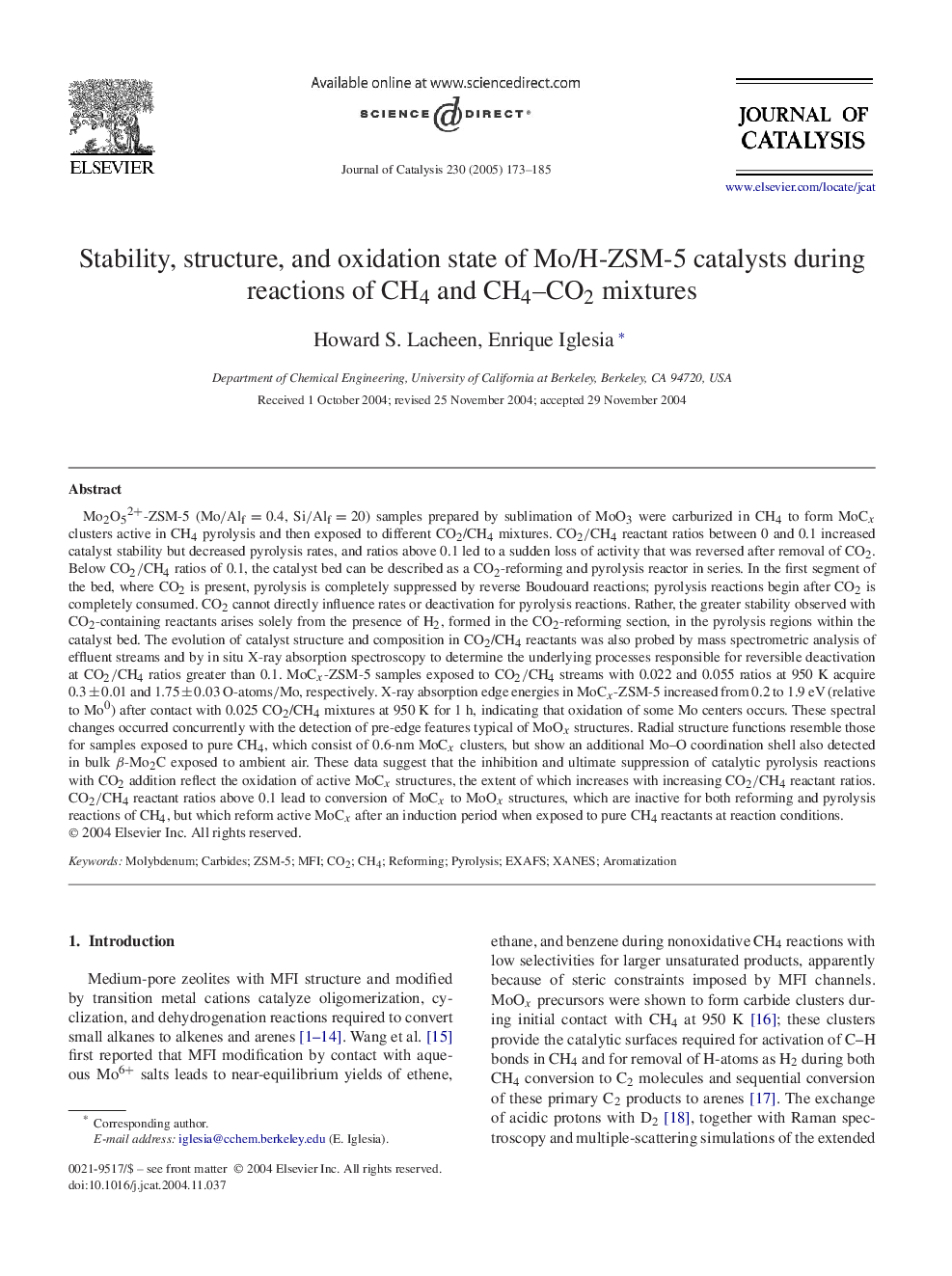| کد مقاله | کد نشریه | سال انتشار | مقاله انگلیسی | نسخه تمام متن |
|---|---|---|---|---|
| 10244540 | 47692 | 2005 | 13 صفحه PDF | دانلود رایگان |
عنوان انگلیسی مقاله ISI
Stability, structure, and oxidation state of Mo/H-ZSM-5 catalysts during reactions of CH4 and CH4-CO2 mixtures
دانلود مقاله + سفارش ترجمه
دانلود مقاله ISI انگلیسی
رایگان برای ایرانیان
کلمات کلیدی
موضوعات مرتبط
مهندسی و علوم پایه
مهندسی شیمی
کاتالیزور
پیش نمایش صفحه اول مقاله

چکیده انگلیسی
Mo2O52+-ZSM-5 (Mo/Alf=0.4, Si/Alf=20) samples prepared by sublimation of MoO3 were carburized in CH4 to form MoCx clusters active in CH4 pyrolysis and then exposed to different CO2/CH4 mixtures. CO2/CH4 reactant ratios between 0 and 0.1 increased catalyst stability but decreased pyrolysis rates, and ratios above 0.1 led to a sudden loss of activity that was reversed after removal of CO2. Below CO2/CH4 ratios of 0.1, the catalyst bed can be described as a CO2-reforming and pyrolysis reactor in series. In the first segment of the bed, where CO2 is present, pyrolysis is completely suppressed by reverse Boudouard reactions; pyrolysis reactions begin after CO2 is completely consumed. CO2 cannot directly influence rates or deactivation for pyrolysis reactions. Rather, the greater stability observed with CO2-containing reactants arises solely from the presence of H2, formed in the CO2-reforming section, in the pyrolysis regions within the catalyst bed. The evolution of catalyst structure and composition in CO2/CH4 reactants was also probed by mass spectrometric analysis of effluent streams and by in situ X-ray absorption spectroscopy to determine the underlying processes responsible for reversible deactivation at CO2/CH4 ratios greater than 0.1. MoCx-ZSM-5 samples exposed to CO2/CH4 streams with 0.022 and 0.055 ratios at 950 K acquire 0.3±0.01 and 1.75±0.03 O-atoms/Mo, respectively. X-ray absorption edge energies in MoCx-ZSM-5 increased from 0.2 to 1.9 eV (relative to Mo0) after contact with 0.025 CO2/CH4 mixtures at 950 K for 1 h, indicating that oxidation of some Mo centers occurs. These spectral changes occurred concurrently with the detection of pre-edge features typical of MoOx structures. Radial structure functions resemble those for samples exposed to pure CH4, which consist of 0.6-nm MoCx clusters, but show an additional MoO coordination shell also detected in bulk β-Mo2C exposed to ambient air. These data suggest that the inhibition and ultimate suppression of catalytic pyrolysis reactions with CO2 addition reflect the oxidation of active MoCx structures, the extent of which increases with increasing CO2/CH4 reactant ratios. CO2/CH4 reactant ratios above 0.1 lead to conversion of MoCx to MoOx structures, which are inactive for both reforming and pyrolysis reactions of CH4, but which reform active MoCx after an induction period when exposed to pure CH4 reactants at reaction conditions.
ناشر
Database: Elsevier - ScienceDirect (ساینس دایرکت)
Journal: Journal of Catalysis - Volume 230, Issue 1, 15 February 2005, Pages 173-185
Journal: Journal of Catalysis - Volume 230, Issue 1, 15 February 2005, Pages 173-185
نویسندگان
Howard S. Lacheen, Enrique Iglesia,